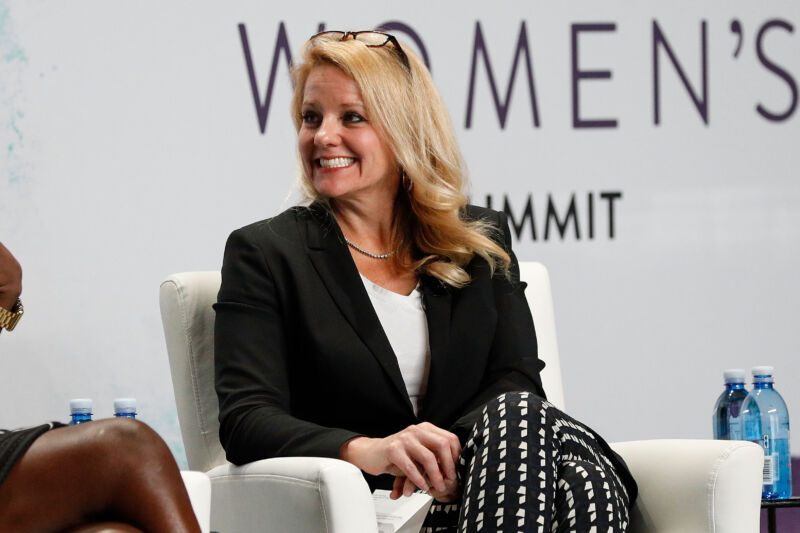Selling Falcons —
“It was easier to sell ‘flight proven’ to customers than it was to sell Falcons.”
Eric Berger
–

Enlarge / Gwynne Shotwell speaks during the 2017 Forbes Women’s Summit in New York City.
Taylor Hill/FilmMagic
SpaceX enjoyed its most successful year in 2020. Amid the pandemic, the company set a record for total number of launches: 26. All met their objectives. The Crew Dragon spacecraft flew humans—Doug Hurley and Bob Behnken—into orbit for the first time. And then it did so again, with the Crew-1 mission in November. SpaceX also made demonstrable progress on its next-generation Starship launch system.
Oh, and the company also became the largest satellite operator in the world with its Starlink internet service.
For SpaceX’s president and chief operating officer, Gwynne Shotwell, 2020 was indeed a watershed year. “It was a year of highlights,” she said in an interview. “There’s probably 10 things that I would look back on this year and say were extraordinary.”
Safely launching astronauts was probably the biggest one, however. “Getting Bob and Doug to orbit and back safely, especially in that timeframe, it was such a terrible time in the world, that was great,” she said.
Shotwell joined SpaceX a few months after Elon Musk founded the company in May 2002. Initially, her job was to sell launches on the small Falcon 1 rocket the company was developing. But over the years, Shotwell earned Musk’s trust—and he earned hers—and has seen her responsibilities grow. This year’s crew missions resulted from a nearly 15-year relationship SpaceX had with NASA to first launch cargo and then astronauts to the International Space Station. Shotwell negotiated that first contract, signed in 2006, and has worked closely with NASA since. Attending the Crew-1 launch was a special moment for her.
Selling flight-proven rockets
Shotwell has also been busy working with commercial satellite customers and getting them increasingly comfortable with launching on previously flown rockets. The vast majority of SpaceX’s Falcon 9 rockets now employ previously flown first stages.
Unless a customer has a strong argument one way or the other, the decision on what booster to use is left up to SpaceX. “You’re buying a launch service, and we will provide you the best vehicle that we can in the timeframe that you need to fly,” she said. “And we basically put the control for the most part in our hands.”
In truth, Shotwell said, it has not been particularly difficult to convince customers to fly on flight-proven rockets. It has been easier to sell customers on the technology than it was selling them on the first Falcon 1 and Falcon 9 rockets. This is because, with rockets, SpaceX has achieved what it said it would do—develop and fly low-cost, reliable launchers.
“It was easier to sell ‘flight proven’ to customers than it was to sell Falcons,” she said. “Obviously, people come to trust organizations and people to do what they say they’re going to do, when you demonstrate that kind of history. So we said we would get to orbit with Falcon 1, and we did. We said we’d get to orbit with Falcon 9, and we did. We said we’d get to Station, and we did. So the sales pitch became much less difficult.”
Starship
Shotwell has also begun to sell the yet-unproven Starship launch system for commercial launches. In March 2020, the company released an initial “payload user’s guide” for the large rocket, and discussions have been ongoing. However, Shotwell reiterated that the company essentially sells customers a launch capability, not a specific vehicle.
“We have signed deals where we can pick whether it’s a Falcon or a Starship,” she said. “We want to provide launch services, and we want to provide it in the most cost-effective way for us and our customers, and the most reliable way for us and our customers. So we really want that to be in our hands. And we know we have work to do with the insurance community, just like we did with Falcon 9, just like we did with Falcon 9 reuse. So there’s still work to go, but hopefully people trust that we are going to do what we intend to do.”
If there are technical problems with Starship, and it’s late, Shotwell said the company will be able to fall back on the Falcon 9 and Falcon Heavy vehicles. But she said SpaceX has already removed a lot of the risk with its Starship test program. Shotwell noted that the flight of the SN8 Starship prototype in December addressed a lot concerns about the vehicle’s flight profile during a landing.
“We certainly de-risked that program pretty massively with that,” she said of the flight. “You always have schedule concerns and issues, but the amount of flight hardware down in Boca with that team is really impressive.” Asked if she thinks Starship will reach orbit in 2021, Shotwell said, “I’m voting yes.”
Starship is the culmination of a lot of what SpaceX has been working toward in its 18 years of existence. Shotwell took the plunge and joined the then unknown company because, like Musk, she believed there were faster, more efficient ways to do aerospace. With its Falcon 1 and Falcon 9 programs, the company endured some growing pains, but now with the Starship program, it can draw upon those lessons and move fast. SpaceX is building Starship vehicles at a rate of greater than one per month and will look to accelerate that pace in 2021. The scale of the project, and rate at which the company is building these massive rockets, is unprecedented in the space industry.
“We don’t do it to embarrass people, but we certainly are happy to provide examples on how industries and companies can do better,” Shotwell said. “We’re not here to be negative—we’re here to provide some objective evidence and some truths that you can do better in this industry, and this industry deserves to be better.”

